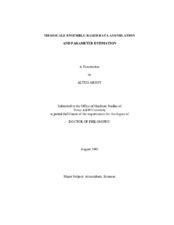| dc.description.abstract | The performance of the ensemble Kalman filter (EnKF) in forced, dissipative
flow under imperfect model conditions is investigated through simultaneous state and
parameter estimation where the source of model error is the uncertainty in the model
parameters. Two numerical models with increasing complexity are used with simulated
observations.
For lower complexity, a two-dimensional, nonlinear, hydrostatic, non-rotating,
and incompressible sea breeze model is developed with buoyancy and vorticity as the
prognostic variables. Model resolution is 4 km horizontally and 50 m vertically. The
ensemble size is set at 40. Forcing is maintained through an explicit heating function
with additive stochastic noise. Simulated buoyancy observations on land surface with
40-km spacing are assimilated every 3 hours. Up to six model parameters are
successfully subjected to estimation attempts in various experiments. The overall EnKF
performance in terms of the error statistics is found to be superior to the worst-case scenario (when there is parameter error but no parameter estimation is performed) with
an average error reduction in buoyancy and vorticity of 40% and 46%, respectively, for
the simultaneous estimation of six parameters.
The model chosen to represent the complexity of operational weather forecasting
is the Pennsylvania State University-National Center for Atmospheric Research MM5
model with a 36-km horizontal resolution and 43 vertical layers. The ensemble size for
all experiments is chosen as 40 and a 41st member is generated as the truth with the
same ensemble statistics. Assimilations are performed with a 12-hour interval with
simulated sounding and surface observations of horizontal winds and temperature. Only
single-parameter experiments are performed focusing on a constant inserted into the
code as the multiplier of the vertical eddy mixing coefficient. Estimation experiments
produce very encouraging results and the mean estimated parameter value nicely
converges to the true value exhibiting a satisfactory level of variability. | en |


